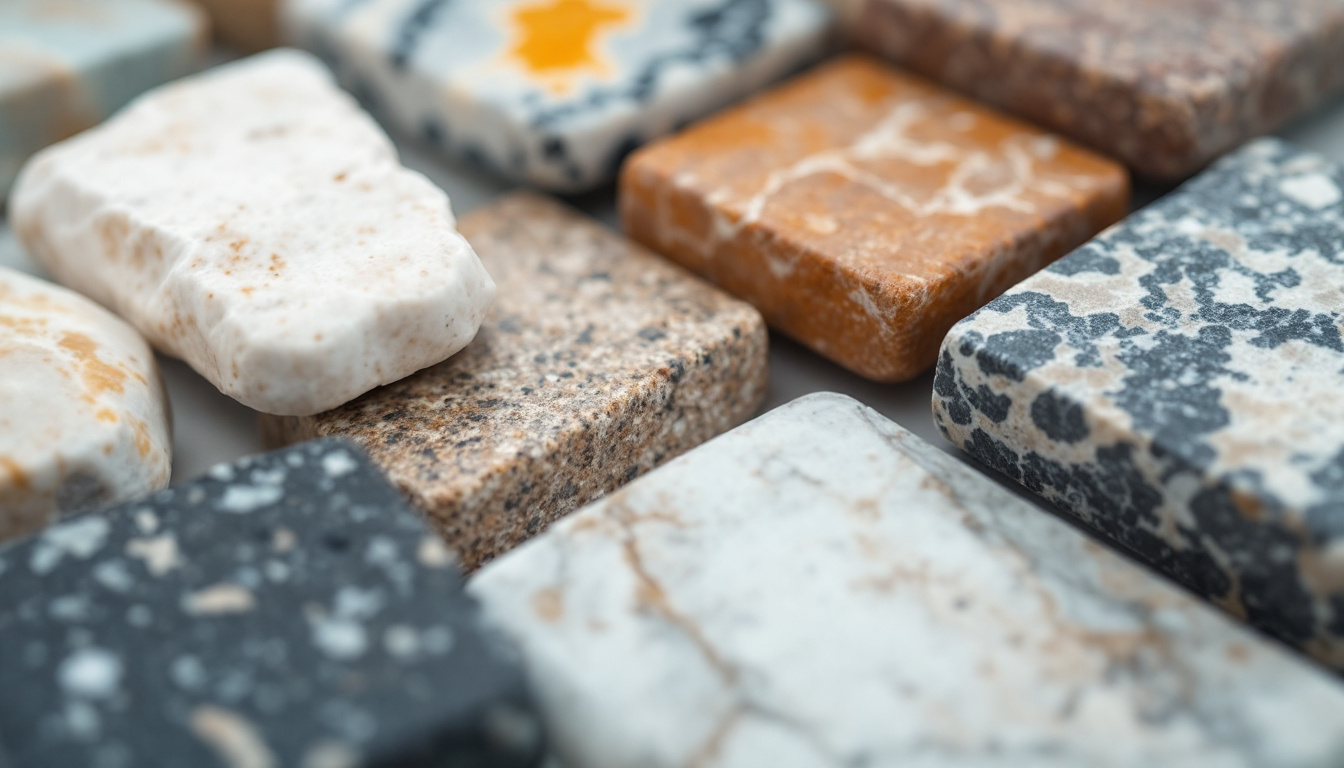
The world of bespoke natural stone interiors is a fascinating one, filled with a rich variety of materials, techniques, and design possibilities. From the quarries where the stone is sourced, to the skilled artisans who shape it into unique pieces, every step of the process is marked by a deep respect for the natural beauty of the stone and a commitment to creating interiors that are both functional and aesthetically pleasing.
Stone sourcing is a critical part of this process, as the quality, color, and texture of the stone can greatly influence the final result. It is not simply a matter of finding a stone that looks good, but also understanding its properties, how it will behave when cut and shaped, and how it will interact with other elements in the interior. This article will delve into the intricacies of stone sourcing, providing a comprehensive glossary of terms and concepts related to this fascinating field.
Understanding Natural Stone
Natural stone is a term that encompasses a wide range of materials, each with its own unique properties. These include granites, marbles, limestones, sandstones, and slates, among others. Each type of stone is formed through different geological processes, which give it its distinctive characteristics. For instance, granite is formed from cooled magma, which gives it its hardness and resistance to heat, while limestone is formed from the remains of marine organisms, which gives it a softer, more porous texture.
When sourcing stone for bespoke interiors, it is important to understand these properties, as they will influence not only the look of the finished piece, but also its functionality and durability. For instance, a marble countertop may look stunning, but it is also prone to staining and scratching, so it may not be the best choice for a busy kitchen. On the other hand, a granite countertop would be much more resilient, but it may not offer the same level of aesthetic appeal.
Granite
Granite is a popular choice for bespoke natural stone interiors due to its durability and wide range of colors and patterns. It is an igneous rock, formed from the cooling and solidification of magma deep within the earth’s crust. This slow cooling process allows large crystals to form, giving granite its characteristic grainy appearance.
The color of granite can vary greatly, depending on the minerals it contains. For instance, granite that is rich in quartz and feldspar will be light in color, while granite that contains a lot of mica and amphibole will be darker. This wide range of colors and patterns makes granite a versatile material for interior design, suitable for everything from countertops and flooring to wall cladding and decorative accents.
Marble
Marble is another popular choice for bespoke natural stone interiors, prized for its elegance and timeless beauty. It is a metamorphic rock, formed from limestone that has been subjected to high temperatures and pressures within the earth’s crust. This process causes the limestone to recrystallize, forming a denser rock with a characteristic veined appearance.
The color of marble can range from pure white to black, with a wide range of hues in between. The veins are usually a different color from the rest of the rock, and they are caused by impurities such as clay, silt, sand, iron oxides, or chert that were present in the original limestone. These veins can be very subtle or quite dramatic, adding to the visual appeal of the stone.
Stone Sourcing Process
The process of sourcing stone for bespoke natural stone interiors involves several steps, from the initial selection of the stone, to the extraction, processing, and finally, the installation. Each step requires a deep understanding of the stone and its properties, as well as a keen eye for quality and aesthetics.
The first step in the process is the selection of the stone. This involves visiting quarries, inspecting the stone, and choosing the specific slabs or blocks that will be used. The selection process is critical, as it determines the quality, color, and pattern of the stone that will be used in the interior.
Quarry Visits
Visiting a quarry is an essential part of the stone sourcing process. It allows the designer or architect to see the stone in its natural environment, to understand its properties, and to select the specific slabs or blocks that will be used. During a quarry visit, the designer or architect will inspect the stone for quality, color, and pattern, and they may also take samples for further testing.
A quarry visit also provides an opportunity to understand the extraction process, which can influence the quality of the stone. For instance, some quarries use explosives to break the stone, which can cause cracks and other defects. Others use wire saws or other cutting tools, which can provide a cleaner cut. Understanding these processes can help the designer or architect make informed decisions about the stone they choose.
Extraction and Processing
Once the stone has been selected, it is extracted from the quarry and processed into the desired shape and size. This can involve cutting the stone into slabs or blocks, polishing it to enhance its natural beauty, and finishing it to achieve the desired texture. The extraction and processing methods used can greatly influence the final look and feel of the stone, so it is important to work with a supplier who uses high-quality, sustainable practices.
The extraction process begins with the drilling of holes into the stone, which are then filled with a special type of wire that is used to cut the stone. This wire is coated with a compound that contains diamond dust, which allows it to cut through the stone with precision. Once the stone has been cut, it is removed from the quarry and transported to a processing facility, where it is cut into slabs or blocks, polished, and finished.
Quality Control in Stone Sourcing
Quality control is a critical aspect of stone sourcing, as it ensures that the stone meets the highest standards of quality and aesthetics. This involves inspecting the stone at various stages of the sourcing process, from the initial selection at the quarry, to the extraction and processing, and finally, the installation.
The quality of a stone can be influenced by a variety of factors, including its mineral composition, the conditions under which it was formed, and the methods used to extract and process it. For instance, a stone that was formed under high pressure and temperature will be denser and more durable, while a stone that was formed under lower pressure and temperature may be softer and more porous. Similarly, a stone that was extracted using explosives may have cracks or other defects, while a stone that was cut with a wire saw will have a cleaner, more precise cut.
Inspection and Testing
Inspection and testing are key components of the quality control process. This involves visually inspecting the stone for defects such as cracks, fissures, or discoloration, as well as testing it to determine its physical and chemical properties. These tests can include density, absorption, compressive strength, and abrasion resistance, among others.
The results of these tests can provide valuable information about the stone’s durability, resistance to wear and tear, and suitability for different applications. For instance, a stone with a high absorption rate may not be suitable for a kitchen countertop, as it could absorb liquids and stains. On the other hand, a stone with a high compressive strength would be ideal for a floor or wall cladding, as it could withstand the pressure of foot traffic or the weight of other materials.
Installation and Maintenance
The final stage of the stone sourcing process is the installation and maintenance of the stone. This involves installing the stone in the desired location, sealing it to protect it from stains and damage, and maintaining it to ensure its beauty and durability over time. The installation process requires a high level of skill and precision, as the stone must be cut and fitted perfectly to achieve the desired look and function.
Maintenance is also a critical aspect of stone sourcing, as it ensures that the stone retains its beauty and functionality over time. This can involve regular cleaning, sealing, and polishing, as well as repairing any damage that may occur. Proper maintenance can greatly extend the lifespan of the stone, making it a sustainable and cost-effective choice for bespoke natural stone interiors.
Conclusion
Stone sourcing is a complex and fascinating process, involving a deep understanding of the natural properties of stone, a keen eye for quality and aesthetics, and a commitment to sustainable and ethical practices. From the initial selection of the stone at the quarry, to the extraction, processing, and installation, every step of the process is marked by a respect for the natural beauty of the stone and a desire to create interiors that are both functional and aesthetically pleasing.
Whether you are a designer, architect, or homeowner, understanding the stone sourcing process can help you make informed decisions about the materials you choose for your bespoke natural stone interiors. By choosing high-quality, sustainably sourced stone, you can create interiors that are not only beautiful, but also durable, functional, and respectful of the natural world.
Discover the Art of Stone with A F Jones Stonemasons
Embark on a journey to transform your space with the timeless elegance of bespoke natural stone interiors. At A F Jones Stonemasons, we bring over 160 years of heritage and innovation to every project, ensuring your vision is realized with precision and artistry. From our state-of-the-art manufacturing workshops in the rolling hills of Oxfordshire to our showroom where inspiration takes shape, we are equipped to handle projects of any scale, from grand architectural endeavors to intimate private commissions. Our knowledgeable team is ready to guide you through the full project process, making the complex simple and turning challenges into triumphs. Make an enquiry today and let us help you unlock the true potential of stone in your next project.


